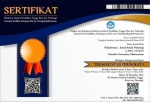Kontrol Diri dan Komunikasi Interpersonal Terhadap Perilaku Phubbing
Abstract
Penelitian ini dilatarbelakangi oleh banyaknya penggunaan smartphone bermasalah yang dapat memicu perilaku phubbing yang disebabkan oleh kurangnya kontrol diri dan komunikasi interpersonal sehingga dapat meningkatkan perilaku phubbing mahasiswa Universitas Mulawarman. Penelitian ini menggunakan pendekatan kuantitatif dengan sampel penelitian berjumlah 88 mahasiswa yang dipilih dengan menggunakan teknik purposive sampling. Metode pengumpulan data yang digunakan adalah skala kontrol diri, komunikasi interpersonal, dan perilaku phubbing. Data yang terkumpul akan dianalisis dengan uji analisis regresi linear berganda. Hasil penelitian menunjukkan bahwa terdapat pengaruh kontrol diri dan komunikasi interpersonal terhadap perilaku phubbing pada generasi Z mahasiswa Universitas Mulawarman Samarinda dengan nilai signifikan F = 14.857, R2 = 0.259, dan p = 0.000. Terdapat pengaruh kontrol diri terhadap perilaku phubbing dengan (ß) = -0.370, t = -4.319 dan p = 0.000. Terdapat pengaruh komunikasi interpersonal terhadap perilaku phubbing dengan (ß) = -0.150, t = -2.078 dan p = 0.041.
This study based on the high number of problematic smartphone use that can trigger phubbing behavior caused by a lack of self-control and lack of interpersonal communication skills so as to increase phubbing behavior of Mulawarman University students. This study uses quantitative approach with a sample of 88 student who were selected using purposive sampling technique. Data collection methods used are the self control scales, interpersonal comunication, and phubbing behavior. Research data will be analyzed with multiple linear regression. The result showed that there was an impact of self control and interpersonal communication on phubbing behavior in Z generation students of Mulawarman University Samarinda with F value = 14.857, R2 = 0.259, and p = 0.000. There is a impact of self control on phubbing behavior with (ß) = -0.370, t = -4.319 and p = 0.000. There is a impact of interpersonal communication on phubbing behavior with (ß) = -0.150, t = -2.079 and p = 0.041
Keywords
Full Text:
PDFReferences
Auter, P. J. (2007). Portable social groups: willingness to communicate, interpersonal communication gratifications and cell phone use among young adult. International Journal of Mobile Communication, 5(2), 139-156. https://doi.org/10.1504/IJMC.2007.011813.
Averill, J. R. (1973). Personal control over aversive stimuli and its relationship to stress. Psychological Bulletin, 80(4), 286-303. https://doi.org/10.1037/h0034845.
Bencsik, A., Csikos, G., & Juhaz, T. (2016). Y and Z Generations at Workplaces. Journal of Competitiveness, 8(3), 90–106. https://doi.org/10.7441/joc.2016.03.06.
Billieux, J., Van der Linden, M. d'Acremont, M., Ceschi, G., & Zrematten, A. (2007). Does impulsivity relate to perceived dependence and actual use of the mobile phone?. Applied Cognitive Psychology, 21(4), 527 - 537. https://doi.org/10.1002/acp.1289.
Brkljacic, T., Sakic, V., & Lipovcan, L. K., (2018). Phubbing among croatian students. Protection and promotion of the well-being of children, youth, and families. 109-126. https://www.researchgate.net/publication/329480038_Phubbing_among_Croatian_students.
Choliz. (2012). Mobile phone addiction in adolescence: The Test of Mobile Phone Dependence (TMD). Journal Progress in Health Sciences, 2(1), 33-44. https://www.researchgate.net/publication/284690452.
Chotpitayasunondh, V., & Douglas, K. M. (2016). How “phubbing” becomes the norm: The antecedents and consequences of snubbing via smartphone. Computers in Human Behavior, 63, 9-18. http://dx.doi.org/10.1016/j.chb.2016.05.018.
Chotpitayasunondh, V., & Douglas, K. M. (2018). Measuring phone snubbing behavior: Development and validation of the Generic Scale of Phubbing (GSP) and the Generic Scale of Being Phubbed (GSBP). Computers in Human Behavior, 88, 5–17. http://doi.org/10.1016/j.chb.2018.06.020.
Devito, J. A. (2013). The Interpersonal Communication Book (13th ed.). Pearson Education, Inc.
Hadi, S. (2006). Metodologi research. Pustaka Pelajar.
Imron (2020, November 10). Medsos Jadi Penyebab Perceraian Tertinggi Kedua di Lamongan. IDN Times Jatim. https://jatim.idntimes.com/news/jatim/imron/medsos-jadi-penyebab-perceraian-tertinggi-kedua-di-lamongan/full.
Irawati, A. N., & Nurmina. (2020). Perbedaan perilaku phubbing pada dewasa awal dalam situasi hubungan keluarga, hubungan pertemanan, dan hubungan percintaan di kota bukittinggi. Jurnal Proyeksi, 15(2), 141-150. http://jurnal.unissula.ac.id/index.php/proyeksi/
Karadag, E., Tosuntas, S. B., Erzen, E., Duru, P., Bostan, N., Sahin, B. M., Culha, I., & Babadag, B. (2015). Determinants of phubbing, which is the sum of many virtual addictions: A structural equation model. Journal of Behavioral Addictions, 4(2), 60–74. http://doi.org/10.1556/2006.4.2015.005
Makmun, S. (2013). Memahami orang lain melalui keterampilan mendengar secara empatik, Jurnal Humaniora, 4(1), 422-431. https://doi.org/10.21512/humaniora.v4i1.3452.
Nazir, T., & Bulut, S. (2019). Phubbing and what could be its determinants: A dugout of literature. Psychology, 10, 819-829. https://doi.org/10.4236/psych.2019.106053.
Nazir, T., & Pişkin, M. (2016). Phubbing: A Technological Invasion Which Connected the World But Disconnected Humans. The International Journal of Indian Psychology, 3(68). https://doi.org/10.25215/0304.195.
Putra, A. Y., Ifdil. & Afdal. (2019). Deskripsi tingkat kecanduan smartphone berdasarkan minat sosial. Jurnal Aplikasi IPTEK Indonesia, 3(1), 9–16. https://doi.org/10.24036/4.13276.
Reza, I. F. (2018). Dimensions of phubbing among moslem adolescents in revolution industry 4.0 perspective mental health. Proceeding of International Conference of Mental Health, Neuroscience, and Cyberpsychology (IcomethNCP).
Sugiyono. (2015). Metode penelitian kombinasi (mix methods). Alfabeta.
DOI: http://dx.doi.org/10.30872/psikoborneo.v9i3.6504
Refbacks
- There are currently no refbacks.
Copyright (c) 2021 Psikoborneo: Jurnal Ilmiah Psikologi

This work is licensed under a Creative Commons Attribution-ShareAlike 4.0 International License.
Indexing by :
________________________________________
PSIKOBORNEO: Jurnal Ilmiah Psikologi Published by Faculty of Social and Political Siences, University of Mulawarman, Samarinda, East Kalimantan and This work is licensed under a Creative Commons Attribution-ShareAlike 4.0 International License.
________________________________________
PSIKOBORNEO: Jurnal Ilmiah Psikologi
Department of Psychology
Faculty of Social and Political Siences, University of Mulawarman
Jl. Muara Muntai Kampus Gn. Kelua Samarinda 75411
Phone: +62 813 35350368
E-Mail: psikoborneo@gmail.com / psikoborneo@fisip.unmul.ac.id

















